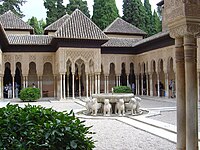Patio de los Leones
( Court of the Lions )The Court of the Lions (Spanish: Patio de los Leones) or Palace of the Lions (Spanish: Palacio de los Leones) is a palace in the heart of the Alhambra, a historic citadel formed by a complex of palaces, gardens and forts in Granada, Spain. It was commissioned by the Nasrid sultan Muhammed V of the Emirate of Granada in Al-Andalus. Its construction started in the second period of his reign, between 1362 and 1391 AD. Along with the Alhambra, the palace is part of a UNESCO World Heritage Site. It was minted in Spain's 2011 limited edition of €2 Commemorative Coins.
The Palace of the Lions is one of the most famous palaces in Islamic architecture and exemplifies the apogee of Nasrid architecture in Al-Andalus. The architecture of the palace presented a significant shift in the design of Nasrid palaces and introduced new trends in ornamentation. The building consists of a rectangular courtyard centered on a marble fountain with twel...Read more
The Court of the Lions (Spanish: Patio de los Leones) or Palace of the Lions (Spanish: Palacio de los Leones) is a palace in the heart of the Alhambra, a historic citadel formed by a complex of palaces, gardens and forts in Granada, Spain. It was commissioned by the Nasrid sultan Muhammed V of the Emirate of Granada in Al-Andalus. Its construction started in the second period of his reign, between 1362 and 1391 AD. Along with the Alhambra, the palace is part of a UNESCO World Heritage Site. It was minted in Spain's 2011 limited edition of €2 Commemorative Coins.
The Palace of the Lions is one of the most famous palaces in Islamic architecture and exemplifies the apogee of Nasrid architecture in Al-Andalus. The architecture of the palace presented a significant shift in the design of Nasrid palaces and introduced new trends in ornamentation. The building consists of a rectangular courtyard centered on a marble fountain with twelve sculpted lions. Four main halls surround the courtyard, along with some upper-floor rooms. Water channels connect the central fountain with smaller fountains in the four halls. The halls feature some of the most elaborate and sophisticated muqarnas vaults in the Islamic world.
 Example of a muqarnas vault in the Hall of Kings (Sala de los Reyes) in the Palace of the Lions. The extensive use of muqarnas was a feature of Nasrid architecture under Muhammad V.[1]
Example of a muqarnas vault in the Hall of Kings (Sala de los Reyes) in the Palace of the Lions. The extensive use of muqarnas was a feature of Nasrid architecture under Muhammad V.[1]The Alhambra was a self-contained palace-city surrounded by fortifications, built up by the Nasrid rulers of the Emirate of Granada in the 13th to 15th centuries. Multiple palaces were added and expanded over the years by different rulers. The Palace of the Lions was added by Muhammad V, who is also responsible for other important contributions to the Alhambra.[2][3] The period of Muhammad V's reign is considered by scholars to mark the apogee of Nasrid architecture, characterized in particular by a profusive use of muqarnas (stalactite-like sculpting) and three-dimensional muqarnas vaults.[1]
The chronology of construction in the Palace of the Lions is not clearly established, but it took place during Muhammad V's second reign (1362–1391), after his return from a period of exile.[4] The Hall of the Two Sisters (Sala de Dos Hermanas), on the north side of the court, was completed in 1362 or between 1362 and 1365, when Muhammad V was celebrating his return to the throne and was also refurbishing the Mexuar and the Comares Palace.[5] According to scholar Felix Arnold, the rest of the palace was built between 1377 and 1390.[2] Some scholars have suggested that the palace was most likely completed in 1380.[4] Inscriptions throughout the palace feature poems by Ibn Zamrak, a poet and long-serving vizier at the time, which suggests that he was probably involved in its design.[6]
The area the Palace of the Lions was built on was formerly part of a larger garden or riad. Much of the area around it remained an open garden afterward, including the area on its north side which is now occupied by the Patio de Lindaraja (Courtyard of Lindaraja).[2] Possibly because of this, the palace's original name may have been Qasr ar-Riyad (Arabic: قصر الرياض, lit. 'Palace of the Garden').[2][3] During the Nasrid era, the palace was completely independent from the nearby Comares Palace to the west and had its own street entrance.[7] On the south side of the palace, separated from it by a narrow street, was the Rawda (Arabic: روضة), the dynastic mausoleum of the Nasrids, of which only the foundations remain today.[6]
A widely-held scholarly view is that the palace was intended to serve as a private residence with a more intimate character than the Comares Palace, which served more official public functions.[8][9][3] It may have served as a pleasure palace for entertainment.[10] In his 2004 book on the Alhambra, Robert Irwin argued that while this interpretation is plausible, there is little direct evidence about the palace's function.[9] It has also been suggested that the palace was built to commemorate Muhammad V's victories, in particular his retaking of Algeciras in 1369. Robert Irwin states that there is no direct evidence for this interpretation either and that the chronology of events makes it unlikely.[11] However, the loot gained from those victories may have helped Muhammad V finance his construction projects.[11]
One theory by art historian Juan Carlos Ruiz Souza proposes that the palace may have actually been a madrasa and zawiya instead. According to this interpretation, the so-called Hall of Kings (Sala de los Reyes) and the Hall of Muqarnas (Sala de los Mocárabes) would have served as the palace library, the Hall of Two Sisters (Sala de Dos Hermanas) would have been a multifunctional space, the upstairs Court of the Harem (Patio del Harén) would have been a residential apartment for the person in charge of the madrasa, and the Hall of the Abencerrajes (Sala de los Abencerrajes) would have served as the madrasa's oratory and possibly also as the mausoleum of Muhammad V himself.[12] Another scholar commenting on this theory, Cynthia Robinson, argues that while its function as a formal madrasa and a mausoleum may be hard for scholars to accept, the building could have still functioned as a kind of bayt al-ḥikma ("house of knowledge") – meaning a place dedicated to education, contemplation and other intellectual or cultural activities – aimed at a royal Nasrid audience and related to their patronage of Sufism.[13]
After the Reconquista The Patio de Lindaraja was created in the 16th century on the site of a former Nasrid garden just north of the Palace of the Lions.
The Patio de Lindaraja was created in the 16th century on the site of a former Nasrid garden just north of the Palace of the Lions.Granada was conquered by the Catholic Monarchs of Spain in 1492 and the Alhambra became a palace owned by the Spanish monarchy. Like much of the Alhambra, the Palace of the Lions suffered damages and underwent various repairs, restorations, and modifications over time. Under the Catholic Monarchs, it was connected to the Comares Palace by a direct passage for the first time, as it remains today.[7]
Starting in 1528, emperor Charles V commissioned the construction of new apartments in the area to the north of the palace.[14] The former gardens on the north side of the palace, which had allowed for an uninterrupted view of the city on this side, were turned into an enclosed garden during this period, resulting in the present Patio de Lindaraja.[15] Additionally, the original entrance to the Palace of the Lions, on its south side, was suppressed in order to make a connection to the new Renaissance-style Palace of Charles V.[16][17] Modifications were also made to the fountain inside the Court of the Lions during the second half of the 16th century.[18]
In 1590 the western chamber of the palace, the Sala de los Mocarabes, was destroyed by the explosion of a nearby gunpowder magazine. The room's former muqarnas-vault ceiling, now lost, was eventually replaced by a Baroque-style plaster vault in 1714, designed by painter Blas de Ledesma for the visit of Phillip V and Isabella of Parma.[19][20]
In the 19th century, probably during the French occupation (1810–1812),[21] the floor of the courtyard was replaced with gardens – although there has been much debate among scholars as to whether gardens had previously existed in the courtyard.[22][23]
In 1859 the architect Rafael Contreras "restored" the courtyard's eastern pavilion by giving it a spherical dome roof with ceramic tiling, based in part on Iranian architecture. This conformed to what European restorers at the time thought the "Arab style" should look like. The domed roof was disassembled in 1934 by Leopoldo Torres Balbás and replaced with its current pyramidal roof, which set off an international debate about the nature of restorations. Torres Balbás argued for a more scientific approach to restoration, in contrast with the more "stylistic" restoration philosophy of his predecessors. Nonetheless, Torres Balbás's roof is still partly incorrect, as its angles are too steep compared with similar pyramidal roofs in Moorish architecture.[24][25]
Recent restorationsIn 2002, the Patronato de la Alhambra (the official agency in charge of the historical site) began a major and comprehensive restoration of the Court of the Lions. This involved the temporary removal of the fountain's lion sculptures and modifications to its hydraulic system. The restoration of the fountain and most of the courtyard was completed in 2012.[26][27][28] One of the last steps in the restoration was the replacement of the courtyard's previous gravel flooring with a pavement of Macael marble flagstones, a decision based on the study of historical archives and on new archeological investigations showing that the underlying rock bed would have made the topsoil too thin for gardens.[29][30][31] A recent study of some of the muqarnas compositions around Court of the Lions was able to identify deformations and imperfections that have occurred due to the many repairs and restorations that took place across generations.[32] The Sala de los Reyes is still undergoing further restoration work. A project to restore its three painted leather ceilings was completed in 2018,[33] while a new project to restore the stucco decoration below these ceilings began in July 2022.[34]
Restorations of the Court of the Lions over time



































Add new comment